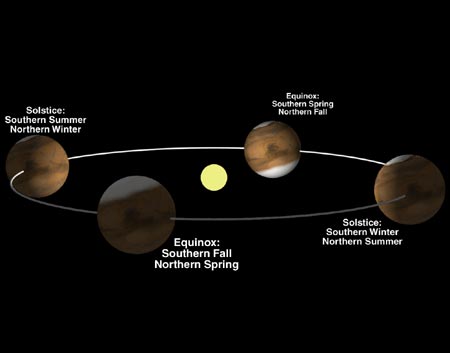”Does Mars have seasons?” is an easy question to answer. Yes, Mars has seasons. The planet experiences all four seasons that the Earth does, but, since the year is longer on the planet, the axial tilt is different, and Mars has a more eccentric orbit than Earth, the seasons are not the same length as each other or the same in each hemisphere. Why does Mars have seasons? Because, like Earth, its axis is tilted away from the Sun.
On Mars, in the northern hemisphere to be exact, spring is the longest season. The Martian year is nearly twice as long as an Earth year(1.88 years), the seasons last longer as well. Here is how a Martian year in the north breaks down: Spring…7 months, Summer…6 months, Fall…5.3 months, and Winter…just over 4 months. Even in the summer months it is very cold. Temperatures at the height of the season may not top -20 C. In the south the temperatures can be as much as 30 C warmer during the same season. The great fluctuations in temperature and the difference in warmth between hemispheres can cause huge dust storms. Some can affect just a small area, while others can cover the entire planet. The larger storms usually occur when the planet is near its aphelion(closest point to the Sun). When there are global dust storms there is no way for scientists to visualize the planet’s surface.
Now that you have the answer to ”does Mars have seasons?”, you might wonder if the planet has always had the same climate. Most scientists doubt it has. Scientific evidence suggests that the planet has seen warmer and colder periods over its existence, much like Earth has. A radar instrument on the Mars Express has turned up water ice, a mineral mapping instrument has discovered chemicals formed in a wet environment, and its camera has picked out features on the surface formed by running water. The cameras also show a huge valley, Kasei Valles, that was probably carved by a gigantic glacier. Additional research has shown evidence of glaciers at varying latitudes. This would seem to indicate that the planet formerly had a different degree of axial tilt, which would have made for a much different environment and potential seasonal variations.
Mars does have seasons. They are not the same as the seasons the planet experienced millenia ago and may not be the same in the future. Earth has seen the same climate changes. Planetary evolution is ongoing, hopefully the spacecraft on and around the planet will tell us more, soon.
Here’s an article describing Spirit surviving 1000 days on Mars, going through all the seasons. And another on the discovery of mid-latitude glaciers on Mars, evidence that the planet was much more tilted in the past.
Here is some great information from the Adler Planetarium about the Martian climate and seasons. And some more detailed information from Malin Space Science Systems.
Finally, if you’d like to learn more about Mars in general, we have done several podcast episodes about the Red Planet at Astronomy Cast. Episode 52: Mars, and Episode 91: The Search for Water on Mars.
Sources:
NASA
Geosociety.org

